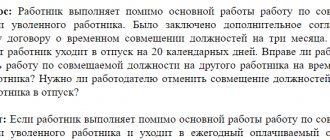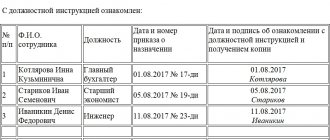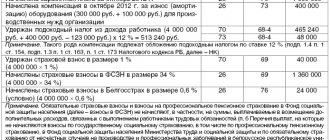Labor Code of the Russian Federation in Art. 151 requires additional payment to an employee when combining positions. The amount of payment for performing duties not included in the job description during working hours is determined by agreement between the parties to the employment contract and must be recorded in writing.
Dear readers! The article talks about typical ways to resolve legal issues, but each case is individual. If you want to find out how to solve your particular problem , contact a consultant:
+7 (499) 110-56-12 (Moscow)
+7 (812) 317-50-97 (Saint Petersburg)
8 (800) 222-69-48 (Regions)
APPLICATIONS AND CALLS ARE ACCEPTED 24/7 and 7 days a week.
It's fast and FREE !
What it is
Combining professions (for working personnel) or positions (for administrative and engineering personnel) involves performing work beyond that specified in the employment contract.
The definition of such part-time work is given in Article 60.2 of the Labor Code. Additional work is performed within the main working hours without overtime, by increasing the intensity and productivity of labor.
An important difference between part-time work and part-time work is the performance of additional tasks not in free time, but during working hours. Combination is possible only at the main place of work.
Several situations in which a citizen is assigned to perform additional tasks are regulated in a similar way:
- combination;
- performing the duties of a temporarily absent employee, incl. if there is a vacancy;
- the emergence of an additional amount of work within the main specialty.
A combination can be arranged only if the employee agrees with both the additional work assigned and the payment for its implementation. The combination is formalized in writing.
https://youtu.be/aNl073dZEzw
What is the difference
Very often, many citizens confuse combining professions with part-time work and vice versa. So, here you need to see a clear difference between the two concepts.
Part-time work is understood as the performance by an employee of duties in another position in his free time from his main job. The duration cannot be more than four hours a day. In turn, performing additional duties during official time is a combination of professions (positions). The Labor Code of the Russian Federation provides for certain remuneration in this case.
Therefore, these two concepts are completely different from each other. Because the whole point of combining professions is that the additional work should be carried out by the employee during his official time. In addition, the subordinate receives a certain monetary reward for this.
While part-time work involves a citizen performing official duties at the same or another enterprise in his free time from his main activity. In this case, an employment contract is concluded with a person, not an agreement.
How to apply
When combining positions, you do not need to enter into a new contract. The provisions of Article 57 of the Labor Code of the Russian Federation refer to the description of the labor function, i.e. tasks performed by the employee, to the mandatory terms of the contract.
Agreements between the parties on combining professions or positions must be formalized by an additional agreement in writing. Its obligatory condition is the amount of payment established for the combination.
After signing the agreement, the employer issues an organization order (or other administrative document) entrusting the employee with an increased amount of work. The employee confirms agreement with the order with a personal signature.
The additional agreement must reflect 4 points of agreement between the organization and the employee:
- the basis for performing the work (vacancy, temporary absence of a colleague, increase in the amount of work, etc.);
- content of the job (position, profession);
- description of duties (additional job function);
- work start date.
If additional work is assigned for a specific period, the agreement and order reflect both the start and end days of the combination period.
A form is possible.
Sample order:
An entry about the combination is not entered into the work book; during this period, the citizen is considered to be working at his main place of work, regardless of the assigned duties.
Important
As a rule, the assignment of additional responsibilities to an employee performing official activities in a given organization, but in a different position, is possible only with his written consent. Therefore, if a subordinate is against combining professions, then the manager does not have the right to force the latter to perform work forcibly. This would be against the law.
In addition, an employee can always refuse to combine several professions ahead of schedule. In turn, the manager can cancel his assignment ahead of schedule by warning his subordinate three days in advance.
How does payment work?
Labor legislation does not oblige an enterprise to pay for part-time work in proportion to production or time worked.
When registering a combination, they use the provisions of the “Explanations of the State Committee for Labor of the USSR and the All-Russian Central Council of Trade Unions of December 1965 “On the procedure for paying for temporary substitution” that do not contradict the current legislation.”
An enterprise can reflect the conditions of combination and the procedure for additional payment in an internal document regulating the remuneration system. Provisions for surcharges must be contained in the collective agreement, if there is one.
The parties can agree on an acceptable remuneration, which can be fixed in the form of a bonus or other type of additional payment.
Payment of additional remuneration is made taking into account:
- number of working days/hours per calendar month;
- production volume;
- or the employee’s salary or tariff rate for the combined position (profession);
- or the amount of a fixed surcharge.
The parameters listed above must be recorded in the order and/or additional agreement to the employment contract. When assigning an additional payment, one should take into account the provisions of Article 22 of the Labor Code, which obliges the enterprise to pay equally for similar work (work of equal value).
It seems reasonable to assign an additional payment for expanding duties in proportion to the basic salary, and when performing the work of a temporarily absent colleague - in an amount not exceeding the full rate of pay.
One of the goals of distributing additional responsibilities among the organization’s personnel is to save wages.
Payments are made according to the rules for the payment of wages and incentive bonuses approved by the enterprise. In accordance with Art. 129 of the Labor Code of the Russian Federation, additional payment for combining positions is wages and is subject to taxation on a general basis.
Types of combination and part-time work
Part-time status is obtained by an employee who, in addition to his main job obligations, performs the duties of an employee who is temporarily absent from his workplace. It is important to note that this type of activity is only available to those workers who are officially employed. It should also be mentioned that additional work obligations are performed only in free time. This means that the employee does not have the right to use his main working time to solve additional production tasks. Part-time work is divided into external and internal forms.
To begin with, we suggest that you familiarize yourself with the internal type of part-time job. With this form of labor activity, the employee assumes obligations to perform additional production tasks. It is important to note that additional job responsibilities are performed only during free hours. It should also be said that the areas of primary and additional activities may differ. According to the current law, the employer and employee of the enterprise must enter into an additional agreement, which is attached to the employment contract. In this case, the company administration must obtain the employee’s written consent to increase the workload.
External combination has a number of features. First of all, this type of work is performed on the territory of another employer. The current Labor Code contains regulations regulating the length of the working day for employees combining several positions. According to this document, the length of the working day in the second place of work should not exceed more than four hours. In addition, it should be noted that a corresponding employment agreement is concluded with this employee, which fixes the amount of wages, provided benefits and additional payments. The amount of wages is determined by the volume of tasks performed or the length of the working day.
Size
The agreed surcharge must be recorded in writing and signed by both parties. When calculating, it is necessary to take into account the actual time worked.
If the payment for part-time work is determined as a percentage of the salary of the employee himself or the temporarily absent employee whose work he performs, the additional payment at the end of the month is calculated using the formula:
(salary * % additional payment) * (number of days worked/number of working days in a month)
If an employee is entitled to compensation payments, for example, the northern (regional) coefficient or an additional payment for working on a rotational basis, they also apply to the additional payment for part-time work.
The employer does not have the opportunity to reduce the amount unilaterally. Changes in the conditions of combination require adjustments or the conclusion of a new additional agreement.
Limiting Factors
The conclusion of a certain type of legal relationship depends on the type of work performed and categories of employees. The fundamental difference between part-time and part-time work in terms of the use of working time determines legal restrictions for attracting a certain category of citizens to part-time work.
Articles 282, 327 of the Labor Code of the Russian Federation and federal laws regulating the activities of certain structures impose direct prohibitions on the employment of the following persons:
- under the age of majority;
- working in hazardous conditions in cases of similar additional work;
- vehicle drivers;
- law enforcement officials;
- municipal and government employees;
- judges and prosecutors.
In addition to the formal classification of persons into certain categories, there are a number of restrictions due to the impossibility of fulfilling a certain labor “mission” according to the specifics of the activity within the framework of the main and additional work.
Limiting factors have the following features:
- Impossibility of being in two workplaces at the same time. For example, an employee registered as a delivery service courier cannot simultaneously work as a dispatcher or watchman.
- Standardization of working hours. It is prohibited to exceed the time of part-time work by more than four hours after working a shift at the main place. Although the Labor Code does not prohibit regulating contracts by quantity, 24-hour employment will be difficult to prove, citing physical capabilities.
- Formation of the remuneration amount. The combination of positions and professions does not require reference to a specific amount, but a clearly expressed underestimation will raise a number of questions among Trudoviks in terms of violation of the rights of workers, and excessive overestimation will raise questions among tax authorities regarding the legality of attribution to the expenditure side when forming the taxable base for profits.
- Voluntariness of the concluded agreement. If with part-time work there is no obligation to conclude an agreement without the employee’s desire, and with external part-time work desire is the main attribute of legal relations, then when combining there are nuances. For example, an employee submitting a resignation letter two months in advance and using earned vacation rights during the “work period” obliges the employer to make a decision on appointing a person responsible for the work that turns out to be “unassigned.”
Concluding legal relations without taking into account limiting factors is fraught with the imposition of penalties on legal entities and individuals using hired labor, in accordance with Article 5.27 of the Code of Administrative Offenses, therefore, the difference between a number of factors of combination and part-time employment should be used by the employer to avoid questions during inspections.
In what cases is it canceled?
Both parties have the opportunity to terminate the additional agreement and terminate agreements on combining professions (positions) in a simplified manner by notifying the other party three days in advance (Article 60.2 of the Labor Code of the Russian Federation).
Termination of an additional agreement to an employment contract is regulated by Art. 72 of the Code, which requires all changes to be made in writing in the form of a bilateral document.
Cases of termination of combination:
- at the request of the employee;
- at the initiative of the organization;
- in connection with the completion of the agreed period of combination;
- automatically upon termination of the employment relationship at the initiative of any of the parties to the employment contract.
It is necessary to notify the other party of your intention to terminate the agreement in writing. The fact of notification must be confirmed by the signature of an authorized manager or employee.
After the expiration of the three-day period, the combination stops. The enterprise issues an order to terminate the combination of professions (positions) in relation to a specific employee. Upon dismissal, a separate application to terminate the combination is not required.
In law
The performance by an employee of an organization of other work during his official time for a certain fee is a combination of professions. The Labor Code provides for its legislative regulation in the articles:
- Art. 60 - implies the possibility of assigning additional work to an employee in the same or another specialty;
- Art. 151 talks about payment for combination;
- Art. 60.2 contains the rules on the basis of which employees perform duties in another position during their official time;
- Art. 149 states that the combination differs from normal working conditions and is therefore subject to additional payment.
Peculiarities
The ban on combining positions for managers (directors, heads of structural divisions and chief specialists) of organizations, which was provided for by a resolution of the Council of Ministers of the USSR in 1981, was declared invalid by the Supreme Court of the Russian Federation in 2003.
Features of combining positions for a director are as follows:
- on the part of the organization, the decision on combination and additional payment for it is made by the person or body authorized to hire the director and conclude an employment contract with him;
- The specifics of the employment contract for the head of the organization, for example, the duration of the probationary period and the procedure for termination, apply to his work in the form of part-time work.
Unlike part-time work, when combining professions or positions, no additional approvals or issuance of organizational and administrative documents are required when granting the employee another leave. Issues of absence from work are considered based on the main position.
If the employer, having entrusted the employee with additional duties, has not formalized the agreement in writing, the employee may demand payment in a legal way, including going to court.
Judicial practice shows that email correspondence and witness testimony are accepted as evidence of combination (see, for example, Decision of the City Court of Nikolaevsk-on-Amur No. 2-1143/2014 of February 5, 2015).
Combination involves the performance of additional work by an employee of the organization with appropriate payment. It is possible only within one organization and requires the signing of an additional agreement to the employment contract.
Additional payment for performing the duties of an absent employee or for increasing the volume of work is made, as a rule, within the limits of the wage fund due to savings.
Part-time and combination: main differences, table
In the process of carrying out the economic activities of a business entity, unforeseen production tasks often arise that require immediate solutions.
Due to the fact that the volume of work may not be enough to attract full-time workers, the employer has the right to hire a part-time worker or assign additional responsibilities to an employee with whom an employment relationship has already been established.
Many employers still do not fully understand such concepts as part-time work and combination work, what the difference is, and in what production situation their use is relevant. To understand what part-time work and combination work are, you need to understand each concept, the nuances of registration, conduct of activities, and payment for work results.
Assigning additional responsibilities to an employee
Kinds
Types of part-time jobs
There are two types of part-time activities:
- Internal, which involves performing work for the employer with whom the main relationship is established. The solution of production problems is carried out in a time period not related to the main working time. It is relevant to use such relationships if the manager has available vacancies.
- External, when activities are carried out outside the enterprise where the employee has a work book.
Legislative regulation, prohibitions and restrictions
All part-time workers carrying out activities for business entities in the status of an individual enterprise or legal entity are subject to the norms of the Labor Code of the Russian Federation applied to regulate the relationship between the employer and the employee.
For the standard list of professions, there is no need to obtain permission from the main employer to conduct activities as an external part-time worker.
The head of a business entity, as well as representatives of the collegial executive body, will have to obtain permission from the founders at the council if the constituent documents or legislative norms establish special labor regulation conditions for them.
The legislation provides for a restriction on the performance of part-time work, regulated by the possibility of carrying out activities in this mode for no more than 4 hours a day.
This is due to concern for the health of the employee, whose body may be subject to overload, as well as compliance with the interests of the employer in the form of preventing a decrease in the quality of work performed and an increase in the level of injuries.
Applicable restrictions on the working hours of a part-time worker
Regulatory acts provide a list of categories of workers who cannot be employed in additional work.
These include minors, employees of government agencies, as well as citizens employed in their main position at work, which is regulated by dangerous and harmful conditions.
The employer does not have the right to put pressure on employees in their desire to carry out part-time activities.
Legal norms do not limit the number of employers with whom an employee has the right to cooperate, subject to compliance with the conditions for limiting additional time.
Violation of legislative norms related to circumvention of prohibitions and restrictions is fraught with penalties for the organization in the amount of up to 50,000 rubles.
How to apply
The relationship between an individual and an employer should be sealed by an employment contract, which must indicate that the activity will be carried out part-time.
The position must be included in the staffing schedule. The basis for signing the agreement is the employee’s statement, which reflects his request for a part-time job.
It is important in the document to display information about the name of the position for which he is applying, as well as the date of its preparation.
Types of contracts drawn up with employees carrying out part-time activities
The consolidation of relations ends with the signing of an employment agreement, as well as the drawing up of an order for hiring an employee. The need to fill out a work book is not regulated at the legislative level, however, an entry in the document can be made at the request of the employee.
To issue a work book in person at the main place of work, you must provide the personnel employee with a certificate of admission to part-time work or a copy of the order.
In case of internal part-time work, personal files of employees relating to their activities must be kept by the personnel inspector.
Termination of relationship
The grounds for terminating an employment contract with a part-time worker are identical to the reasons for terminating the main agreement.
The relationship also terminates if the employer hires an employee for a vacant position and assigns him the duties of a part-time worker as his main activity.
Upon his dismissal from his main job, the employer has the right to reconsider relations with him in order to conclude a main contract and transfer him to full-time work.
The decision of the head of the business entity is recorded by drawing up an additional agreement and making a corresponding entry in the work book.
What is more profitable for the employer?
And what is the difference between a part-time job and a part-time job from the point of view of the employer, for whom a completely understandable desire is to ensure the progress of the work process with minimal costs. From the point of view of remuneration, it is undoubtedly more profitable for the employer to arrange a combination. In addition, the combination is entrusted to an employee already familiar to management. The management knows in advance the strengths and weaknesses of the employee and can calculate the amount of work that he is guaranteed to cope with.
Part-time work can be beneficial for a company in a state of financial crisis. In this situation, paying a part-time worker part-time will be much more profitable than paying the main employee for downtime or transferring him to a shorter working day. Another advantage for the employer is that paying taxes for a part-time worker is significantly lower.
How to apply for them with the same employer
There are differences in the document flow when registering such employees.
An employee is hired to work part-time with the conclusion of an employment contract. This agreement contains:
- The provisions, rights, obligations and guarantees of the employee are similar to the standard contract concluded for the main job.
- Indication of the performance of part-time duties.
- For time-based work, the salary or rate is indicated, for piece-work, output.
We invite you to familiarize yourself with what you need to apply for sick leave
The agreement may be of a fixed-term or indefinite nature, the duration of which is determined by agreement of the parties. At the request of the employee, an entry about part-time work is made in the work book.
The legislation defines the circle of persons for whom part-time work is not formalized. Additional employment is not allowed:
- Minor citizens.
- Heads of enterprises. Only external part-time work is allowed with the consent of the founders.
- Persons whose main responsibilities involve harmful or dangerous working conditions, if part-time work involves similar work circumstances.
- Employees whose duties are related to transport management.
- State civil servants - police officers, prosecutors, judiciary and law firms.
Persons deprived of the right to register for part-time employment are not limited in their ability to engage in scientific or research activities.
Revision of the terms of the current agreement
Combination under the Labor Code does not require a revision of the current contract, being drawn up as an additional agreement to it, or as a separate document. The key condition that must be specified is the form and volume of the calculation, as well as the time period during which the employee is assigned to perform the duties.
https://youtu.be/jZeJ5B8bm3g
It is important to know! At the same time, a change in the labor function, which in fact represents a combination or expansion of volumes, cannot be a unilateral decision of the employer. It is impossible to change the agreement without the written consent of the other party.
So, Art. 60 of the Labor Code of the Russian Federation prescribes cases when the range of duties of an employee or their scope, provided for by agreement of the parties, changes. In a number of situations, this is permissible with the obligatory (written) consent of the person involved. The only exception is force majeure (accidents, disasters), limited to a maximum period of 1 month.
Part-time employment contract
The second paragraph of the Resolution states that there are jobs that will not be considered part-time work for the same categories of workers (an employment order is also not required and a personal card is not required).
- Carrying out technical, medical, accounting or any other examination where a one-time payment is provided.
- Teaching work with hourly pay (no more than three hundred hours per year).
- Consultations of highly qualified specialists in organizations and institutions (also three hundred hours per year).
- Freelance supervision of doctoral students and graduate students at an educational institution, head of a department, or work by agreement between the employee and the employer with additional payment for faculty management.
- Pedagogical activity in the same institution of secondary vocational or primary education, in preschool educational institutions, institutions of general and additional education for children, as well as in any other children's institution where additional payment is provided.
- Freelance work of teaching staff who manage offices, departments, laboratories, as well as leadership - in cycle or subject commissions, teaching - of heads of institutions, management of industrial training, as well as student practice, duty of medical workers on schedule, but in excess of the monthly norm.
- Overtime work in the same educational institution, including children's, by teachers, accompanists, accompanists.
All this work can be performed during regular hours with the consent of the employer.
All compensation and guarantees that provide for collective agreements, agreements, regulations and the Labor Code of the Russian Federation also apply to part-time workers. However, if they are related to combining study and work, as well as activities in the Far North and other equivalent areas, guarantees and compensation will be provided only at the main place of work.
When applying for part-time work, a separate employment contract must be concluded. The work function in an additional job may be the same as in the main job or different from it.
An employment contract for a part-time worker must include the usual contractual terms and must contain a clause that the work is performed part-time. The contract can be concluded for a certain period or indefinitely.
The work book is not filled out when concluding an employment contract with a part-time worker, but this can be done at the request of the employee. To do this, you must submit a document confirming additional work to the place of your main job (where the work book is kept). Such a document may be a certificate of employment, a certified copy of an order or an employment contract. In case of internal part-time work, the employee’s personal file (if it is maintained) will contain documents related to both jobs.
A part-time employment contract is terminated on the same grounds as in the general case, but an additional reason for terminating the contract will be the hiring of an employee for whom this work will become the main one.
If a part-time worker quits his main job, then at the workplace where he worked part-time, he can be hired full-time. To do this, it is necessary to draw up a corresponding additional agreement to the employment contract with him, and make an entry in the work book stating that the work from such and such a date is the main one for the employee.
What is more profitable for the employee?
Each of these types of work activity has its own disadvantages and advantages. However, the main issue for any employee remains the issue of payment for their additional work.
Advantages of part-time work:
- The opportunity to additionally engage in a fundamentally different type of activity.
- Gaining additional skills that can be very useful in the future.
- Higher wages than combined wages.
At enterprises, such options for labor relations are most often resorted to in cases where the main employee goes on sick leave, vacation or maternity leave. Hiring a new employee for a temporary position is quite troublesome, while offering one of the employees additional income for performing the duties of an absent specialist is much simpler and more convenient.
https://youtu.be/yJfrcbk7EpI
The part-time worker himself is considered an independent staff unit with all the required social guarantees.
Part-time work is also not without its positive aspects:
- An excellent opportunity to improve your skills without leaving your job.
- Receiving a decent increase in your basic salary while working in the same place.
- Strengthening your position in the workforce, increasing your authority in the eyes of management.










